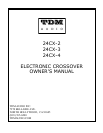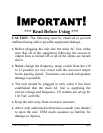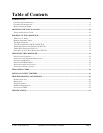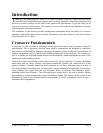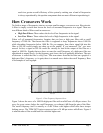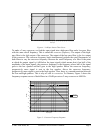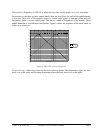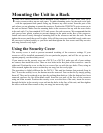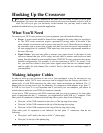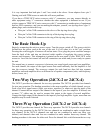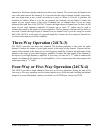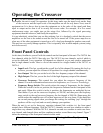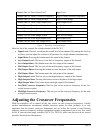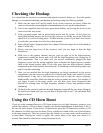
© 2003 TDM Audio, Inc. Electronic Crossover Owner’s Manual Page 6
• External Power: Passive crossovers are simply inserted between the amp and the
speaker components. Active crossovers must be plugged into an electrical outlet in order
to work.
• Higher Typical Rolloff Rates: Passive crossovers typically roll off at rates from 6 to 12
dB per octave. Most modern active crossovers have rates of at least 24 dB per octave
(more about rolloff rates later).
• More Power Amplifiers: Active crossovers break the signal into many different bands
before the power amplifiers. That means that you need one power amp channel per band.
Figure 2 shows a typical active crossover configuration.
Mids Amp
Lows Amp
Highs Amp
Signal
Source
Active
Crossover
Low Transducer
Mid Transducer
High Transducer
Figure 2 - Active Crossover Configuration
Crossover Terminology
• Crossover Frequency: This adjustment is often called the crossover point. It is the
frequency where the sound crosses over from one speaker to another. For example, if
your low-to-mid crossover frequency is 125 Hz, then frequencies below 125 Hz are
reproduced by the low speaker and frequencies above 125 Hz are reproduced by the mid
speaker. 125 Hz itself would be reproduced equally by both the low and the mid speakers.
• Rolloff Rate: A crossover’s rolloff rate determines how sharp the transition between one
set of speakers and another will be. Higher rolloff rates result in faster transitions. To
better understand this concept, let’s take an example.
Suppose you have a crossover stage dividing your mid frequencies and your high
frequencies. The crossover frequency of this stage is 2500 Hz. Sounds at 2500 Hz will be
equally reproduced by both the mid and high frequency speakers. As you go higher in
frequency, more of the sound is reproduced by the high speaker and less by the mid
speaker. As you go lower in frequency more of the sound is reproduced by the mid
speaker and less by the high speaker. If this crossover has a high rolloff rate (24 dB per
octave), at 1250 Hz, the difference between how much sound is reproduced by the mid
speaker and how much is reproduced by the high speaker will be 30 dB. In other words,
at 1250 Hz, 30 dB more of the signal is reproduced by the mid speaker than the high
speaker. At 625 Hz, the difference would be 54 dB. With a low rolloff rate (12 dB per
octave), the difference at 1250 Hz would only be 18 dB, and at 625 Hz it would be 30 dB.
Higher rolloff rates are generally considered good because they help protect speaker
components from damage at frequencies that are too low for them to handle. They also



